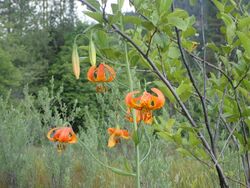Biology:Lilium pardalinum
| Lilium pardalinum | |
|---|---|

| |
| Scientific classification | |
| Kingdom: | Plantae |
| Clade: | Tracheophytes |
| Clade: | Angiosperms |
| Clade: | Monocots |
| Order: | Liliales |
| Family: | Liliaceae |
| Subfamily: | Lilioideae |
| Tribe: | Lilieae |
| Genus: | Lilium |
| Species: | L. pardalinum
|
| Binomial name | |
| Lilium pardalinum Kellogg
| |
| Synonyms[1] | |
|
Synonymy
| |

Lilium pardalinum, also known as the leopard lily or panther lily, is a flowering bulbous perennial plant in the lily family, native to Oregon, California , and Baja California.[1] It usually grows in damp areas. Its range includes California chaparral and woodlands habitats and the Sierra Nevada.[2][3]
Description
Typically L. pardalinum grows to about 2 metres (6.6 ft) high; the tallest and most vigorous plants can reach up to 2.5 metres (8.2 ft). The bulbs are small, and many are usually clustered together on a rhizomatous stock. The flowers are Turk's-cap shaped, red-orange, with numerous brown spots, usually flowering in July. It is a deciduous plant and its dormancy period is in winter. The flower color is either orange, red, or brown.[4] The leaves complexity is simple. The fruits type is capsule.[5]
- Lilium pardalinum subsp. pardalinum Kellogg -- leopard lily - southern California, Baja California
- Lilium pardalinum subsp. pitkinense (Beane & Vollmer) Skinner -- Pitkin Marsh lily - northwestern California
- Lilium pardalinum subsp. shastense (Eastw.) Skinner -- Shasta lily - Oregon, northern California
- Lilium pardalinum subsp. vollmeri (Eastw.) Skinner -- Vollmer's lily - southwestern Oregon, northwestern California
- Lilium pardalinum subsp. wigginsii (Beane & Vollmer) Skinner -- Wiggins' lily - southwestern Oregon, northwestern California
The subspecies Pitkin Marsh lily, Lilium pardalinum subsp. pitkinense, is federally listed as an endangered species.
Cultivation
Lilium pardalinum is cultivated by specialty plant nurseries as an ornamental plant, for use in native plant gardens and wildlife gardening; as well as providing height and colour in the flower border and for cut flowers. It has gained the Royal Horticultural Society's Award of Garden Merit.[8]
References
- ↑ 1.0 1.1 1.2 Kew World Checklist of Selected Plant Families
- ↑ Jepson . accessed 12.1.2011
- ↑ Calflora taxon report Lilium pardalinum Kellogg California Tiger Lily, leopard lily, tiger lily
- ↑ "Tiger Lily, Lilium pardalinum". https://calscape.org/Lilium-pardalinum-().
- ↑ "Lady Bird Johnson Wildflower Center - The University of Texas at Austin". https://www.wildflower.org/plants/result.php?id_plant=LIPA.
- ↑ ITIS Standard Report Page: Lilium pardalinum
- ↑ USDA
- ↑ "Lilium pardalinum". Royal Horticultural Society. https://www.rhs.org.uk/Plants/10221/Lilium-pardalinum-(IXc-d)/Details.
External links
- Jepson Manual Treatment: Lilium pardalinum
- USDA Plants Profile: Lilium pardalinum (leopard lily)
- Labs1.eol.org
Wikidata ☰ Q1263838 entry
 |

